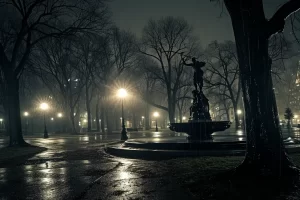Centralia: The Ultimate Ghost Town

Centralia, to sum it up in a quick phrase, is the town that inspired Silent Hill.
If Hell decided to relocate to Earth and claim a zip code, it would inevitably have to sue Centralia for infringing its brand image rights. Yes, this tiny little borough out in the middle of nowhere Pennsylvania in the Columbia County animated that horror franchise. And, once you get to know the history of Centralia, the madness it calls a birthright and the staggering amount of phantasmagorical events it claims as its own it’s really no stretch of the imagination to say nightmares spawn from its blackened heart.
Centralia’s population has waned from more than 1,000 striving inhabitants in 1980 to only five in 2017, and those five are hermits that refuse to abandon their homes.
Pre-Hell Centralia
The Native American tribes in what is presently Columbia County auctioned the land that makes up Centralia to Colonial agents in 1749 for the amount of £500. The tribes, Colonial agents later said, we’re incredibly pleased with the arrangement and in a hurry to pack up and go on to greener pastures.
In 1793, Robert Morris, a champion of the Revolutionary War and a signatory of the Declaration of Independence bought a massive portion of Centralia’s valley. Five years later, in 1798, he declared bankruptcy and surrendered his estate to the Bank of the United States.
A French sea captain named Stephen Girard then bought Morris’ lands for $30,000 at a steal. He dupped the Bank out of prize real estate. The crafty pirate had surveyed the land and uncovered a huge anthracite deposit in the region. That momentous event would eventually lead to Centrailia’s downfall.
The coal deposits were largely ignored until 1854. Meanwhile, the little town prospered and started flowering up. In 1832, Johnathan Faust opened the Bull’s Head Tavern. In 1842, Centralia’s land was acquired by the Locust Mountain Coal and Iron Company. Alexander Rae, a drilling master, relocated his family to the region and began plotting a Centralia 1.0. Rae laid out streets and lots for development. He started drawing in citizens and enticing them with work and new opportunities. Up until this moment, the town was named Bull’s Head – after the only tavern in the area. Rae, deciding that a future capital of mining shouldn’t be associated with a tavern of ill-repute instantly filed a new name; first Centreville then in 1865 to Centralia… Schuylkil County had dibs on Centreville.
From Rags To Riches
The first two mines in Centralia started operating in 1856; the Locust Run Mine and the Coal Ridge Mine. By late 1870, the Town had more than 5 official mine companies and dozens of bootleg drilling operations.
The place was turning a profit. Rae started lobbying in the Hill and lining the pockets of policymakers. In record time, Centralia had blossomed into a rather impressive outskirt. It had everything it could want: schools, Universities, pharmacies, banks, hospitals, a railroad, brothels, pubs. It was bustling.
Tragedy started rearing its ugly head in 1868. On October 17, 1868, Alexander Rae, the town’s founder, was murdered in his buggy by members of a local gang. The local gang had become a staple and worse, it had organized itself from a mere cabal of thieves and highwaymen into a full-blown band of desperados and outlaws. Now known as the Molly Maguires, the ring plunged Centralia into a hotbed of arson, murder, thievery, and violent hijinks.
A legend tells that Father Daniel Ignatius McDermott, the first Roman Catholic priest to call Centralia home, blighted the land in punishment for being attacked by three members of the Maguires in 1869. McDermott announced that there would be a day when his church, St. Ignatius Roman, would be the only structure remaining in Centralia.
Apocalypse Now
This was a world where no human could live, hotter than the planet Mercury, its atmosphere as poisonous as Saturn’s. At the heart of the fire, temperatures easily exceeded 1,000 degrees Fahrenheit . Lethal clouds of carbon monoxide and other gases swirled through the rock chambers.
— David DeKok, Unseen Danger: A Tragedy of People, Government, and the Centralia Mine Fire (University of Pennsylvania Press, 1986.
On May 7, 1962, the Centralia Council gathered to discuss the approaching Memorial Day and how the town would finally clean the Centralia landfill. The landfill was made up of a 50-foot-deep mine that over the year; the town officials using this hole as a repository for all their trash. In 1956, Pennsylvania had passed a law regulating stip mined and their use as landfills. The state was barking up the Council’s back and they were feeling the heat.
The town council decided to arrange and executed a rapid cleanup.
“The minutes of the meeting and all plans for execution of this plan have since been lost. What little remains, transcripts of conversations, don’t describe the proposed procedure. Rules and state regulation prohibited dump fires… Something the City Council saw as a fast, efficient, and cheap way of getting rid of the problem.”
The Centralia council set a date and appointed five members of the volunteer firefighter organization to clean up the landfill. A fire was ignited on May 27, 1962, and it all went to hell in a handbasket rather fast. Flames started appearing out from crevices all over Centralia. The fire department was out of its league once the coal underneath and the trash was sparked awake.
The labyrinth of old mines under the borough started to catch fire and the baking heat, the fumes, the smoldering columns of flames, started to engulf the town. Fixures started appearing all over Centralia as ash rained from above; the region coated in a layer of gray.
Mine inspectors from other parts of the state were quickly brought in. Their assessment of the situation was bleak; the gases seeping from the pits and crack contained a high concentration of carbon monoxide.
There were 3 failed attempts to douse the fire.
The Cover-Up
For almost 10 years, the council downplayed the fact that Centralia was wavering on top of a huge coal fire. “Mum’s the word,” was the general edict when approaching flammable topics. Business as usual, just don’t breath in the air if you can.
In late 1976, David DeKok began reporting on the mine fire for The News-Item an out of town paper that didn’t have to adhere to the general gag order of Centralia’s ruling class. In the span of 10 years, David covered the silent tragedy and published over 500 articles about the mine fire. In 1979, locals became aware of the range of the quandary when a gas-station owner embedded a dipstick into one of his underground tanks to control the fuel level. When he retracted it, it seemed a bit too hot. So, he went and lowered a thermometer on a string… the temperature of the gasoline tank was a scorching 172ºF.
By now, the locals were starting to realize there was something hinky in the air and something fishy in the halls of governance. Cancer and lung diseases were spreading like wildfire. Health-related issues normally seen in cases of severe carbon monoxide or carbon dioxide poisoning were plaguing the local hospitals. Meanwhile, the council kept their mouth shut.
It all came to a head, and the state had no choice but to perk up when a sinkhole mushroomed suddenly below 12-year-old Todd Domboski and swallowed the kid whole. Todd clung to a tree root for dear life. Eric Wolfgang his cousin pulled the young Todd out and saved his life. A plume of hot steam, billowing from the hole puffed out and infected the town with lethal levels of carbon monoxide. In City Hall, the mayor packed his bags as his assistant told him that pandemonium had broken loose.
Aftermath
- In 1984, Congress earmarked more than $42 million for relocation efforts. Most of the inhabitants accepted buyout proposals and moved out of Centralia.
- In 1992, Pennsylvania governor Bob Casey requested eminent domain on all properties in the district. He condemned all the buildings within.
- In 2002, the U.S. Postal Service revoked Centralia’s ZIP code, 17927. Making it an official no-fly zone. It no longer existed as a town.
- The Centralia mine fire also spread beneath the town of Byrnesville, a few miles to the south. The hamlet had to be evacuated and leveled.
Ghost Of Centralia
The Centralia area has forthwith developed into a tourist attraction. Visitors come to view the vapors on Centralia’s empty streets, travel its ghostly mazes with gasmask, post for selfies in abandoned streets. The Route – PA ROUTE 61 – is popularly known as Graffity Highway; artistic depictions of demons, devils, and ghouls welcoming the miasma of Dark Tourism enthusiast.
The town has endless tales of ghosts and creatures roaming the nights. Rae’s spirit condemning all who come and laugh at his folly. Dark beast, covered in fur, stalking the streets – imps and goblins released from their underground prisons by the raging inferno.
Tales of the supernatural abound… as the hanged leaders of the Molly Maguires drag their feet and reenact crimes on fume soaked street, a prophetic priest screaming to the four winds:
“And I heard, as it were, the noise of thunder. One of the four beasts saying ‘come and see’. And I saw, and behold a pale horse….and his name that sat on him was Death, and Hell followed with him.”
Sources:
https://en.wikipedia.org/wiki/Centralia_mine_fire
http://www.slate.com/blogs/atlas_obscura/2014/06/04/centralia_a_town_in_pennsylvania_destroyed_by_a_mine_fire.html
http://www.offroaders.com/album/centralia/ghosttown.htm

